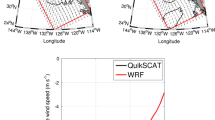Abstract
Analysis of three-dimensional wind profiles recorded by an acoustic sounder near Cape Town has indicated that extreme subsidence (-35 cm s-1) is a mean feature throughout the atmospheric boundary layer (50–1000m) during summertime southerly winds. Over the SW Cape coast, the atmospheric subsidence translates into a N-S gradient of the mean summer water deficit (-20 to -32 cm month-1). The rapid drying out of the air mass along a northward trajectory is linked to a number of factors including synoptic-scale divergence of the surface wind and the effects of the local orography which produce a hydraulic jump of the southerly wind. The along-coast reduction in sea surface temperature provides a major constraint on the height of the moist marine layer. As the depth of the marine air mass shrinks, its potential for inland penetration becomes limited. In addition, dry air is entrained towards the surface as evidenced by aerial survey data. A model is formulated which indicates the importance of the surface heat fluxes in reducing the depth of the Agulhas air mass as it passes northward over the SW tip of Africa during summer.
Similar content being viewed by others
References
Atkinson, B. W.: 1981, Mesoscale Atmospheric Circulations, Academic Press, London, 495 pp.
Friehe, C. and Schmidt, K.: 1976, ‘Parameterisation of the Air-Sea Interface Fluxes of Sensible Heat and Moisture by Bulk Aerodynamic Formulas’, J. Phys. Oceanogr. 6, 801–809.
Gill, A. E.: 1982, ‘Atmosphere-Ocean Dynamics’, Int. Geophys. Series 30, Academic Press, London, 662 pp.
Guastella, L.: 1988, ‘The Sea Surface Heat Balance in the Benguela Upwelling Region’, M.Sc. Thesis, Oceanogr. Dept., Univ. Cape Town, 202 pp.
Heydenrych, C. M.: 1987, ‘A Climatology of the Coastal Low in the SW Cape’, M.Sc. thesis, Env. Geogr. Sci. Dept., Univ. Cape Town, 135 pp.
Hoflich, O.: 1984, ‘Climate of the South Atlantic Ocean’, in H. Van Loon (ed.), Climates of the Ocean, World Survey of Climatology, 15, Elsevier, Amsterdam, 48–66, 95–98.
Hsu, S. A., Fett, R. and LaViolette, P. E.: 1985, ‘Variations in Atmospheric Mixing Height across Oceanic Thermal Fronts’, J. Geophys. Res. 90(C2), 3211–3224.
Jury, M. R.: 1984, ‘Wind Shear and Differential Upwelling Along the SW Tip of Africa’, Ph.D. thesis, Oceanogr. Dept., Univ. Cape Town, 161 pp.
Jury, M. R.: 1987, ‘Aircraft Observations of Meteorological Conditions Along Africa's West Coast Between 30–35° S’, J. Climate Appl. Meteorol. 26(11), 1540–1552.
Jury, M. R. and Walker, N. D.: 1988, ‘Marine Boundary Layer Modification Across the Edge of the Agulhas Current’, J. Geophys. Res. C 93, 647–654.
Jury, M. R. and Spencer-Smith, G.: 1988, ‘Doppler Sounder Observations of Trade Winds and Sea Breezes Along the African West Coast Near 34° S’, Boundary-Layer Meteorol. 44, 373–405.
Kamstra, F.: 1985, ‘Environmental Features of the Southern Benguela with Special Reference to the Wind Stress’, in L. V. Shannon (ed.), South African Ocean Colour and Upwelling Experiment, Sea Fisheries Res. Inst., Cape Town, 13–27.
Kondo, J.: 1975, ‘Air-Sea Bulk Transfer Coefficients in Diabatic Conditions’, Boundary-Layer Meteorol. 9, 91–112.
Newton, C. W.(ed.): 1972, ‘Meteorology of the Southern Hemisphere’, Meteorol. Monogr. 13, 35, Amer. Meterorol. Soc., Boston.
Preston-Whyte, R. A., Diab, R. D., and Tyson, P. D.: 1977, ‘Towards an Inversion Climatology of Southern Africa: Part 2, Non-surface Inversions in the Lower Atmosphere’, S. Afr. Geogr. J. 59, 45–59.
Riehl, H.: 1979, Climate and Weather in the Tropics, Academic Press, London, 611 pp.
Smith, L. D. and VonderHarr, T.: 1988, ‘Temporal Variability of the Earth Radiation Budget from Nimbus-7 NFOV Data’, J. Clim. Appl. Meteorol., (in press).
Snow, C. S.: 1985, ‘Mist Interception by Three Species of Mountain Fynbos’, M.Sc. thesis, Env. Geogr. Sci. Dept., Univ. Cape Town, 96 pp.
Steyn, D. G. and Oke, T. R.: 1982, ‘The Depth of the Daytime Mixed Layer at Two Coastal Sites: A Model and Its Validation’, Boundary-Layer Meteorol. 24, 161–180.
Sweet, W. R., Fett, R., Kerling, J., and LaViolette, P. E.: 1981, ‘Air-Sea Interaction Effects Across the North Wall of the Gulf Stream’, Mon. Wea. Rev. 109, 1042–1052.
Winant, C. D., Friehe, C. A., Dorman, C. E., and Beardsley, R. C.: 1987, ‘Hydraulic Control of the Marine Layer Over Coastal Upwelling Zones’, Proc. Symp. Density-Stratified Flows, Calif. Inst. Tech., Pasadena, California.
Winant, C. D., Dorman, C. E., Friehe, C. A., and Beardsley, R. C.: 1988, The Marine Layer Off Northern California: an Example of Supercritical Flow, J. Atm. Sci., (in press).
Author information
Authors and Affiliations
Rights and permissions
About this article
Cite this article
Jury, M., Reason, C. Extreme subsidence in the Agulhas-Benguela air mass transition. Boundary-Layer Meteorol 46, 35–51 (1989). https://doi.org/10.1007/BF00118445
Accepted:
Issue Date:
DOI: https://doi.org/10.1007/BF00118445




